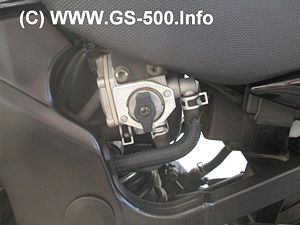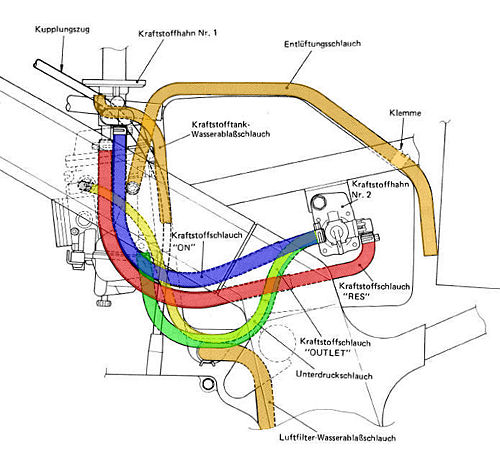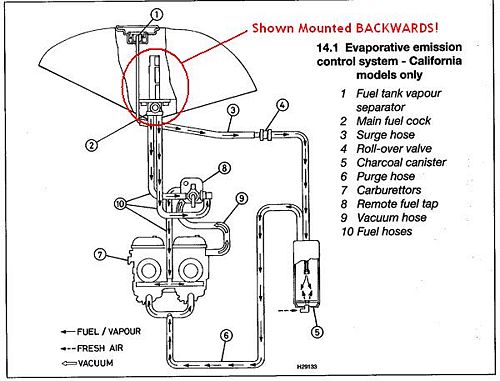Petcock and petrol hose routing
Aus das GS 500 Wiki: www.GS-500.info
| Author: Goose, Translation: theGrinch |
The GS has a petcock which is activated by negative pressure. It has three positions: ON, RES and PRI.
It is an automatic shutdown valve which is supposed to prevent flooding of the carburetors in case of a defect carburetor-valve.
The petrol tank itself also has a petcock which includes a filter, this only has the positions ON and OFF.
Inhaltsverzeichnis |
Positions of the petcock and mechanism (1989-2000)
ON
This is the normal position. The petcock is activated by the negative pressure produced when the engine is started.If the engine is off, no petrol is moving.
RES
This is the postion for reserve. Should the GS die whilst driving, this is the position you need. If you practice this manoeuver, you should be able to do it whilst drving before the engine seizes. The reserve is suitable for about 30 to 50 kilometers (20-35 miles).
If the engine is off, no petrol is moving.
PRI
This position is PRI, an abreviation vor PRIME. This is used to refill the carburetors after they were emptied if the bike was not used for some time, or if the carburetors were cleaned. Be careful, this position can actually flood the carburetors! In this postion, the carburetor valve is the only thing stopping the petrol - is this valve old or worn, the petrol will exit the carburetor straight through the overflow hose.
PRI is the position in which most petrol can flow through the petcock. This can help, if the bike seizes on you after some time at full throttle.
Positions of the petcock and mechanism (2001-today)
ON
This is the normal position. The petcock is activated by the negative pressure produced when the engine is started.If the engine is off, no petrol is moving.
RES
This is the postion for reserve. Should the GS die whilst driving, this is the position you need. If you practice this manoeuver, you should be able to do it whilst drving before the engine seizes. The reserve is suitable for about 30 to 50 kilometers (20-35 miles).
If the engine is off, no petrol is moving.
PRI
This position is PRI, an abreviation vor PRIME. This is used to refill the carburetors after they were emptied if the bike was not used for some time, or if the carburetors were cleaned. Be careful, this position can actually flood the carburetors! In this postion, the carburetor valve is the only thing stopping the petrol - is this valve old or worn, the petrol will exit the carburetor straight through the overflow hose.
PRI is the position in which most petrol can flow through the petcock. This can help, if the bike seizes on you after a longer time at full throttle.
Positions of the upper petrol petcock
The upper petcock (see Hose routing - Kraftstoffhahn Nr. 1) is located underneath the petrol tank and prevents drainage if the hoses are disconnected.
ON
OFF
Hose routing
CAVE: This scheme is one of the few correct ones!Further down you can find some WRONG ones!
The petrol hoses of the GS have 8mm inner and 11mm outer diameter. To exchange all petrol hoses, you need about 1 to 1.5 metres.
Function and coulor of the hoses and routing:
- Red hose
Goes from the front, longer hose of the upper petcock to the rear hose of the lower petcock. This hose is for the reserve.
This hose is covered in heat shrink tubing originally.
- Blue hose
Goes from the rear, shorter hose of the lower petcock to the outer frontal hose of the lower petcock. This hose is for ON.
This hose is covered in heat shrink tubing originally.
- Green hosing
Goes from the inner frontal hose of the lower petcock to the T-piece between the carburetors, it's the connection between the petcock and the carburetor intake.
- Yellow hose
Goes from the backside of the lower petcock to the left carburetor. This is the negative pressure hose. When the engine is running, the negative pressure opens the membrane in the lower petcock and the petrol can flow. - Orange hoses
All air outlet and overflow.
- Carburetor air outlet
Goes from the upper T-piece between the two carburetors above the airbox in between the airbox and the battery, ends there open!
- Petrol tank air outlet
From the thin hose it goes down to the right side of the engine. It also drains petrol and water which accumulates underneath the tank cap.
- Drainage of the airbox
Thick hose from the connector at the bottom of the airbox to the right side of the engine in front of the peg. Ends in a hose with slit (acts as a valve)
Here overflowing petrol (broken float needle valve) or condensation water from the airbox drains. Quiete often oil from the crankcase ventilation is drained here as well.
- Crankcase ventilation
Thick black hose from the small cap on top of the engine, goes straight into the top of the airbox.
Oil fumes from the engine go into the airbox here and from there straight back into the engine.
- Batterydrainage
Thin hose from the right connection at the battery. Goes straight down between engine and rocker, drains directly on the road.
The battery produces gas whilst being charged (hydrogen gas, remember those fun days in the school labs?). This is "drained" via this hose. Take care when changing this hose, a bit of battery acid may be present in there as well!
The upper image is one of the few correct ones.
A lot of images show the upper petcock 180° twisted!
The long noozle has to be towards the front wheel, the stop valve has to face to the right.
These two images are wrong..













